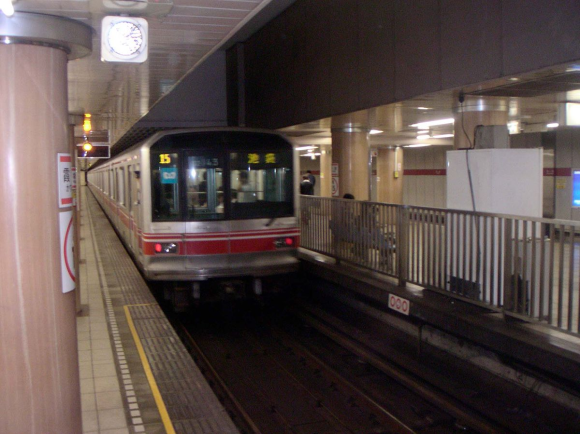
Aum Shinrikyo founder, three other members hanged 23 years after deadly subway attack, more executions likely to follow.
On the morning of March 20, 1995, as commuters were making their way into downtown Tokyo, members of the Aum Shinrikyo cult released sarin nerve gas on trains in the Tokyo subway system, killing 13 and injuring thousands. Less publicized internationally was a sarin attack in the city of Matsumoto, Nagano Prefecture, in 1994, when Aum Shinrikyo members killed eight and injured hundreds while targeting judges who were opposed to the cult building a facility within the city limits, and the 1989 murder of a Yokohama-based lawyer involved in a class action lawsuit against the cult, who was killed in his home along with his wife and 14-month old baby son, all of whom were injected with poison following a violent struggle with cultists.
Subsequent police investigations led to the arrest of Aum Shinrikyo founder Shoko Asahara (born Chizuo Matsumoto) in 1995, and the additional indictment of 192 other members of the organization. Asahara was convicted of masterminding the incidents, and Japan’s supreme court upheld his death penalty in 2006. However, Japanese law prevented the sentence from being carried out until all other members of the organization who were being tried in connection to the events completed their appeals, which didn’t happen until earlier this year.
On the morning of July 6, more than two decades after the Tokyo subway attack and almost 30 years since the murder of the Sakamoto family, the Japanese government has executed Asahara, delivering the punishment through the country’s customary method of hanging.
In addition to the 63-year-old Asahara, three other convicted Aum Shinrikyo members were executed on July 6: Yoshihiro Inoue (48), Tomomasa Nakagawa (55), and Kiyohide Hayakawa (68).
Aside from the four executed cultists, nine other Aum Shinrikyo members are currently on death row. While all were previously being held at the Tokyo Detention House (the facility where executions in Tokyo are carried out), seven of the 13 members facing death penalties were transferred to other facilities in March of this year, leading to speculation that the remaining executions will be carried out in close succession.
Sources: NHK News Web (1, 2) via Livedoor News via Jin, BBC News
Top image: Wikipedia/っ

 Japan executes six Aum Shinrikyo cultists, bringing hanging total to 13 this month
Japan executes six Aum Shinrikyo cultists, bringing hanging total to 13 this month Mass stabbing in Japan leaves 19 dead and dozens injured
Mass stabbing in Japan leaves 19 dead and dozens injured Nine injured in Tokyo after man drives car into pedestrians on Takeshita Street in Harajuku
Nine injured in Tokyo after man drives car into pedestrians on Takeshita Street in Harajuku Kyoto Animation comments on arsonist arrest: “Our friends whose lives were taken won’t come back”
Kyoto Animation comments on arsonist arrest: “Our friends whose lives were taken won’t come back” Kyoto Animation arsonist’s psychological evaluation ends, open door to prosecution
Kyoto Animation arsonist’s psychological evaluation ends, open door to prosecution Seaside scenery, history, and so many desserts on Yokohama’s Akai Kutsu【Japan Loop Buses】
Seaside scenery, history, and so many desserts on Yokohama’s Akai Kutsu【Japan Loop Buses】 Foreigner’s request for help in Tokyo makes us sad for the state of society
Foreigner’s request for help in Tokyo makes us sad for the state of society Japanese city loses residents’ personal data, which was on paper being transported on a windy day
Japanese city loses residents’ personal data, which was on paper being transported on a windy day Ghibli Park now selling “Grilled Frogs” from food cart in Valley of Witches
Ghibli Park now selling “Grilled Frogs” from food cart in Valley of Witches Princesses, fruits, and blacksmiths: Study reveals the 30 most unusual family names in Japan
Princesses, fruits, and blacksmiths: Study reveals the 30 most unusual family names in Japan Historical figures get manga makeovers from artists of Spy x Family, My Hero Academia and more
Historical figures get manga makeovers from artists of Spy x Family, My Hero Academia and more Celebrate another year of life by putting it in jeopardy with this birthday candle flower
Celebrate another year of life by putting it in jeopardy with this birthday candle flower Should you add tartar sauce to Japanese curry rice? CoCo Ichi makes diners an unusual offer
Should you add tartar sauce to Japanese curry rice? CoCo Ichi makes diners an unusual offer Japanese woman stumbles on the power of the infamous “gaijin seat” phenomenon during flight
Japanese woman stumbles on the power of the infamous “gaijin seat” phenomenon during flight French Fries Bread in Tokyo’s Shibuya becomes a hit on social media
French Fries Bread in Tokyo’s Shibuya becomes a hit on social media McDonald’s new Happy Meals offer up cute and practical Sanrio lifestyle goods
McDonald’s new Happy Meals offer up cute and practical Sanrio lifestyle goods Japanese ramen restaurants under pressure from new yen banknotes
Japanese ramen restaurants under pressure from new yen banknotes Studio Ghibli releases new action figures featuring Nausicaä of the Valley of the Wind characters
Studio Ghibli releases new action figures featuring Nausicaä of the Valley of the Wind characters Red light district sushi restaurant in Tokyo shows us just how wrong we were about it
Red light district sushi restaurant in Tokyo shows us just how wrong we were about it New private rooms on Tokaido Shinkansen change the way we travel from Tokyo to Kyoto
New private rooms on Tokaido Shinkansen change the way we travel from Tokyo to Kyoto Tokyo Tsukiji fish market site to be redeveloped with 50,000-seat stadium, hotel, shopping center
Tokyo Tsukiji fish market site to be redeveloped with 50,000-seat stadium, hotel, shopping center Beautiful Ghibli sealing wax kits let you create accessories and elegant letter decorations【Pics】
Beautiful Ghibli sealing wax kits let you create accessories and elegant letter decorations【Pics】 Studio Ghibli releases Kiki’s Delivery Service chocolate cake pouches in Japan
Studio Ghibli releases Kiki’s Delivery Service chocolate cake pouches in Japan New definition of “Japanese whiskey” goes into effect to prevent fakes from fooling overseas buyers
New definition of “Japanese whiskey” goes into effect to prevent fakes from fooling overseas buyers Our Japanese reporter visits Costco in the U.S., finds super American and very Japanese things
Our Japanese reporter visits Costco in the U.S., finds super American and very Japanese things All-you-can-drink Starbucks and amazing views part of Tokyo’s new 170 meter-high sky lounge
All-you-can-drink Starbucks and amazing views part of Tokyo’s new 170 meter-high sky lounge More foreign tourists than ever before in history visited Japan last month
More foreign tourists than ever before in history visited Japan last month New Pokémon cakes let you eat your way through Pikachu and all the Eevee evolutions
New Pokémon cakes let you eat your way through Pikachu and all the Eevee evolutions Disney princesses get official manga makeovers for Manga Princess Cafe opening in Tokyo
Disney princesses get official manga makeovers for Manga Princess Cafe opening in Tokyo Sales of Japan’s most convenient train ticket/shopping payment cards suspended indefinitely
Sales of Japan’s most convenient train ticket/shopping payment cards suspended indefinitely Sold-out Studio Ghibli desktop humidifiers are back so Totoro can help you through the dry season
Sold-out Studio Ghibli desktop humidifiers are back so Totoro can help you through the dry season Japanese government to make first change to romanization spelling rules since the 1950s
Japanese government to make first change to romanization spelling rules since the 1950s Ghibli founders Toshio Suzuki and Hayao Miyazaki contribute to Japanese whisky Totoro label design
Ghibli founders Toshio Suzuki and Hayao Miyazaki contribute to Japanese whisky Totoro label design Doraemon found buried at sea as scene from 1993 anime becomes real life【Photos】
Doraemon found buried at sea as scene from 1993 anime becomes real life【Photos】 Tokyo’s most famous Starbucks is closed
Tokyo’s most famous Starbucks is closed One Piece characters’ nationalities revealed, but fans have mixed opinions
One Piece characters’ nationalities revealed, but fans have mixed opinions We asked a Uniqlo employee what four things we should buy and their suggestions didn’t disappoint
We asked a Uniqlo employee what four things we should buy and their suggestions didn’t disappoint Appeal filed to block death sentence for Kyoto Animation arsonist
Appeal filed to block death sentence for Kyoto Animation arsonist Woman murdered by “cult” at fast food restaurant in China after refusing to give her phone number
Woman murdered by “cult” at fast food restaurant in China after refusing to give her phone number Kyoto Animation arsonist to be finally placed under arrest for July attack that killed 36
Kyoto Animation arsonist to be finally placed under arrest for July attack that killed 36 Guangzhou City to allow co-workers and neighbors to give consent for other people’s organ donations
Guangzhou City to allow co-workers and neighbors to give consent for other people’s organ donations Super Crazy Kun wins seat in Toda City Council election
Super Crazy Kun wins seat in Toda City Council election Anime voice actress arrested for suspected cocaine possession, has name scrubbed from series cast
Anime voice actress arrested for suspected cocaine possession, has name scrubbed from series cast Death penalty formally requested for Kyoto Animation arsonist by prosecutors as trial closes
Death penalty formally requested for Kyoto Animation arsonist by prosecutors as trial closes Kyoto Animation arson attack leads Japanese government to develop stricter gas sale regulations
Kyoto Animation arson attack leads Japanese government to develop stricter gas sale regulations Another Kyoto Animation employee passes away, brings arson death toll to 36
Another Kyoto Animation employee passes away, brings arson death toll to 36 Terrorists release third video of Japanese hostage, say it will be his last
Terrorists release third video of Japanese hostage, say it will be his last Go to hell: Unzen Hot Springs invites visitors to take an infernal stroll through a field of deadly hell-mouths
Go to hell: Unzen Hot Springs invites visitors to take an infernal stroll through a field of deadly hell-mouths Kyoto Animation arsonist develops a soft spot for nurse treating him at hospital
Kyoto Animation arsonist develops a soft spot for nurse treating him at hospital Osaka earthquake: Scenes show damage from strongest tremor to hit the region in decades
Osaka earthquake: Scenes show damage from strongest tremor to hit the region in decades AKB48 idols Anna Iriyama, Rina Kawaei released from hospital
AKB48 idols Anna Iriyama, Rina Kawaei released from hospital
Leave a Reply